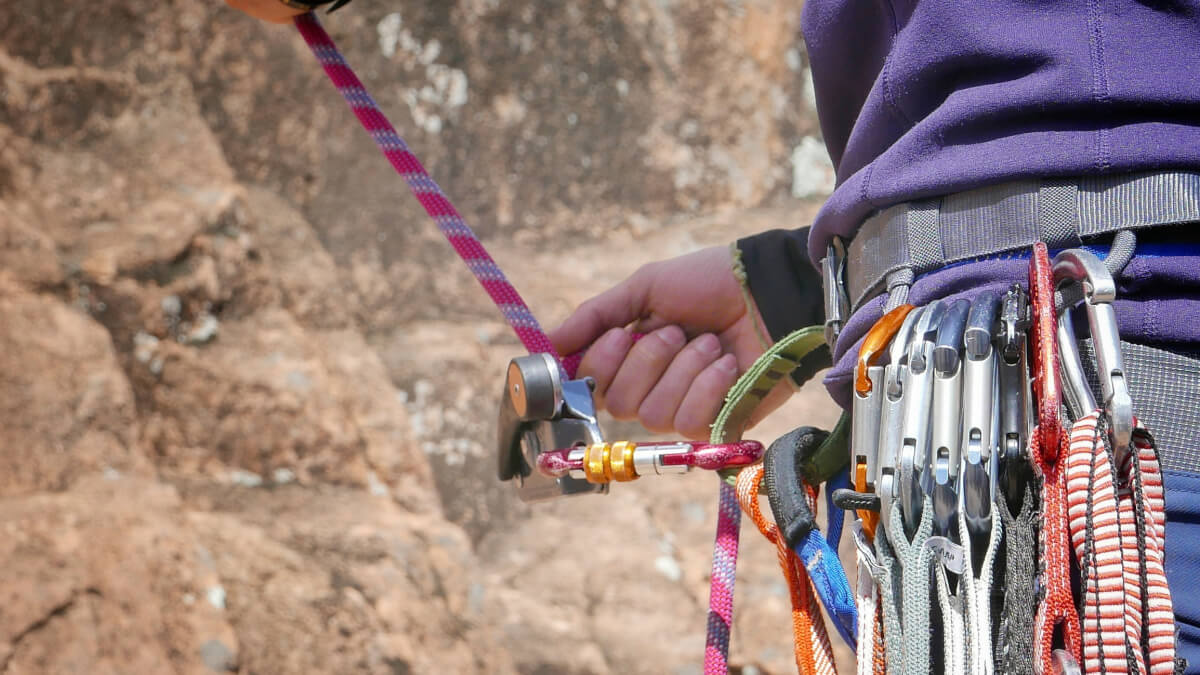Carabiners are necessary for anyone who is into climbing, whether it’s for recreation, sport or as part of an occupation (construction, arboriculture, rescue, etc.). But carabiners can also serve as helpful tools for other activities, such as hiking, camping, or for survival preparations.
Origins
While they have become closely associated with climbing in the past couple of decades, carabiners have a long history before evolving into the items that we know today.
The term “carabiner” comes from the German word “karabinerhaken”, or “carabineer’s hook” — A carabineer was a soldier who specialized in the use of the carbine, a rifle that had a shorter barrel than the usual rifle or musket. To make transportation easier, carabineers carried their rifles with a strap attached via metal hooks. These metal hooks were the early version of the modern carabiner.
At the beginning of the 20th century, a German climber named Otto Herzog started experimenting with the use of metal hooks with a quick-opening gate for use in climbing, after seeing the tool being used by firemen. Although his carabiner was flimsy, the design paved the way for the modern carabiner and made manipulating climbing ropes faster and easier.

Carabiner Types
Decades after Herzog first tinkered with his version of the carabiner, the tool underwent design changes that enabled it to be lighter, safer and at the same time carry more weight. The number of carabiner types reflect these changes, and each type has its own pros and cons.
Most carabiners differ in two main aspects: the shape and the locking mechanism.
Shape
- Oval
The shape closest to the early carabiners. Its basic, uniform shape allows it to be more versatile and hold more gear compared to the other carabiner shapes. However, the oval is not as strong as other more advanced designs and because of its shape, they’re often also heavier.
- D
D-shaped carabiners offer some of the versatility of the oval carabiners with the added advantage of increased load-carrying capacity. This is made possible by shifting the load off the center and into its stronger axis, the spine.Because of this, a smaller and lighter D carabiner can be just as strong as a larger and heavier oval carabiner of the same material. The biggest trade-off to the more advanced design would be the added price you’ll have to pay for a D-shaped carabiner.
- Asymmetric D
Also called an “offset D” or “modified D” carabiner, the asymmetric D is the most popular shape for carabiners. Like the D-shaped carabiners, its tapered end shifts the weight of the load to its sturdier side while further reducing weight, and the larger opening makes it easier to use. Even though asymmetric-D carabiners are often more expensive compared to the two previous types, this doesn’t deter serious climbers from including a couple of asymmetric D carabiners in their go-to kit.
- Pear
A specialized carabiner shape mainly used for belay systems, the pear-shaped carabiner usually has a wide, almost symmetrical top that enables the user to use a crossing hitch knot for controlling descent rates. Like asymmetric D carabiners, it also has a large opening, making it easy to use as well.

Locking Mechanisms
- Non-Locking
Non-locking mechanisms have a spring-loaded “gate” that makes opening easy and closing automatic, as long as nothing gets in the return path of the gate. Straight gate carabiners are probably the most popular type because of their utilitarian design, while some people prefer bent gates for the added ease when inserting rope.Another non-locking gate design is the wire gate. The gate is made of a looped stainless-steel wire that also closes automatically. Because of its simpler construction, it’s lighter than either straight or bent gates, but also less durable. However, a good thing about them is they’re less likely to seize in freezing conditions. There’s also less chance of their gate “fluttering” or opening for a split second when rope runs through it at high speed.
- Locking
Locking mechanisms provide added security and prevent the gate of your carabiner from opening accidentally. This is important in some instances like rescue. Locking mechanisms come in different variants like screw lock, magnetic, twist lock, magnetic, double-gate and others.Carabiners with locking gates offer better security and less chances of the gates opening under load, but are consequently heavier. Aside from the weight, the biggest downside to them is the added complexity to using the tool.
kN Rating and other considerations
Depending on how you want to use them, you have a choice between different sizes, weights and materials. Usually, larger and heavier carabiners can withstand more abuse, are less likely to break even when hoisting heavy loads, and can carry more. However, a big and burly carabiner may be overkill for a small person who just wants to practice safely climbing on an indoor wall, where a lightweight (but from a reputable brand) aluminum climbing carabiner is more appropriate.

Final Word

Before taking the plunge, make sure that your carabiner is made for your intended purpose and comes from a reputable company. There are plenty of knockoffs on the market, and if you’re not careful, you might end up with nothing more than a keyring (although real carabiners also make good key rings). They’re cheap and not bad for minor things like hooking a water bottle to your backpack, hanging food bags on trees, or locking tent doors. But they’re cheap for a reason and should never be used for something priceless: namely, your life or that of another person’s.
Remember- You are responsible for the selection and use of carabiners intended to support any load. Consult a professional trainer for proper instruction in the acquisition and safe use of this equipment.


